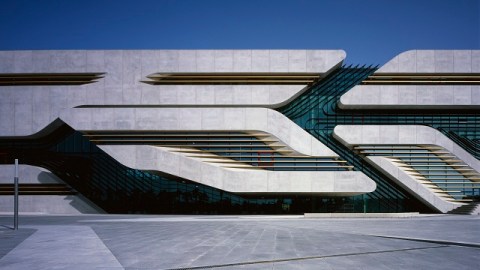Is the Architecture World Sexist?

Women have come a long way in the arts, but there’s still a long way to go. It’s not so unusual to find the work of contemporary women artists in galleries and art historians continue to comb through the past in search of overlooked women visionaries. In the world of architecture, however, the fight for gender equality rages on, but a blast from the past recently put that inequity front and center again. Recently, Denise Scott Brownargued to Architecture Magazine that she should have received equal credit with her business partner and husband Robert Venturi on the 1991 Pritzker Prize, the highest honor for a working architect. “They owe me not a Pritzker Prize,” Brown contended, “but a Pritzker inclusion ceremony.” A petition on Change.org now asks architects and fans of architecture to stand with Brown and compel the Pritzker people to right this wrong. But, as Brown as others demonstrate, the idea of “women architects” as different from the idea of architects with a male default setting continues to cripple women looking to break through (ironically) this particular glass ceiling.
Brown and Venturi worked so closely together that crediting ideas to one or the other seemed futile, and unnecessary. In another interview about the Pritzker problem, Brown explained, “It’s very, very difficult to define us. I’d say that Bob is a very focused person who is surprisingly broad. And I’m a very broad person who is surprisingly focused. Bob is one of the few architects who I feel has a real understanding for urban design.” Brown continually felt frustration as Venturi would receive credit alone for their joint work. “My ideas went where I couldn’t go, you could say,” Brown related. “My ideas were credited, but they were credited to Bob.” In the architecture world, which Brown elsewhere called a “19th-century upper-middle-class men’s club,” Brown existed either as Venturi’s wife or not at all. Venturi himself, when signing the petition, unequivocally stated that “Denise Scott Brown is my inspiring and equal partner.” So, why the delay?
Since its inception in 1979, only two women have won the Pritzker: Zaha Hadid in 2004 and Kazuyo Sejima (jointly with Ryue Nishizawa) in 2010. There’s a precedent in Brown’s favor for dual winners as well, including the awarding in 2001 to a pair from the same firm, Jacques Herzog and Pierre de Meuron. And, yet, just last year, the 2012 winner Wang Shu won with nary a mention of his wife and co-partner Lu Wenyu. The jury for the Pritzker changes each year, so you would hope that their attitudes would change with the times, but the 2012 award and the current delay regarding recognition for Brown seems troubling.
Brown blames the “star system” of architecture that ignores the real-world realities of collaboration on any big project. She also blames a prevailing taste for, although she doesn’t use the phrase, “manly architecture.” In 2008, Brown criticized the Pritzker committee for awarding just one type of architecture. “It took 23 years for them to find a woman [2004 winner Zaha Hadid] who fits the mold that, to them, means great architecture,” Brown said then. “[T]he fact that they couldn’t bend their criteria—they couldn’t see other ways of being an architect. They couldn’t say, ‘Maybe there are various streams.’” In the more recent interview, Brown clarified that older statement by adding, “There’s a million ways to be a woman. There’s a million ways to be a mother. And there’s a million ways to be an architect.” But is there only one way to be a successful, prize-winning, women architect?
Does Zaha Hadid, one of the most successful and internationally renowned architects—male or female—in the world today, design buildings “like a man,” as Brown so deftly says indirectly? Hadid’s latest big project, Pierresvives in Montpellier, France, is the main subject of a beautifully photographed monograph allowing us to be the judge. Helene Binet’s photos (including the one shown above) allow us to see the building, which groups together Montpellier’s archives, media library, and departmental office of sports under one avant-garde roof, from every angle. “The story of Pierresvives is that of a humanistic adventure,” Marie Le Fort writes in the introduction. “This vision results in a light gray concrete futuristic ship softened by a network of colored glass grooves. Pierresvives unwinds like a remarkable architectural gesture in the northwest of Montpellier and confirms, if there were any need for it, Montpellier’s premier reputation in terms of modern architecture… Representing a horizontal ‘tree of knowledge,’ Pierresvives branches out across 650 feet (200 m), flows into a skillfully complex structure that combines transparency, protective facades, and accessibility.” Although Pierresvivres resembles a landed alien mother ship, is there anything “motherly” about it? If you didn’t know a woman had designed it, would you have guessed? Is it possible to read gender in design? Even if you want to argue that the “tree of knowledge” metaphor blooms from some kind of nurturing, Gaia source, isn’t Louis Sullivan’s “form follows function” the foundation of all organic-looking architecture for more than a century? I’m not sure if there is an answer to any of these questions, but Hadid’s building (and this book) at least give us something concrete to look and think about.
I’m not sure if Brown’s cause opened a larger discourse on gender equity in the arts, but it was interesting to see articles titled “Rising Tide Of Art (Finally) Lifts Prices For Women’s Work” (by Ellen Gamerman and Mary M. Lane) and “Even the Score: Female Composers Edge Forward” (by Alex Ross) say positive things about the progress of women in the arts right around the same time. Ross’ article on female contemporary composers offered an interesting counterpoint to the situation in architecture. Ross argues that contemporary composers, both male and female, feel crowded out by the canonical giants of classical music that dominate orchestral programming, so perhaps gender’s not the real culprit in that field as much as anti-modernist bias. In the world of architecture, however, there’s a real demand for contemporary, cutting edge design. Montpellier, the home of Hadid’s latest creation, prides itself on its modern look. Perhaps architecture is the one artistic field where a woman’s work has a chance to stand for itself, which makes the “old boys’ club” mentality, as reflected, according to Brown, in its awards, even sadder. It’s ironic that Hadid drew inspiration for her design from the “tree of knowledge,” which harks back to Eden, Eve, and that fateful apple. Here’s hoping that prejudices and misconceptions about gender as old as Genesis can be buried beneath buildings for us to live, work, and dream in in the future.
[Image:Zaha Hadid. Pierresvives, Montpellier, France. Photography by Helene Binet.]
[Many thanks to Rizzoli USA for the image above from and a review copy of Zaha Hadid: Pierres Vives, written by Zaha Hadid Architects, edited by Stephane Hof, and photographed by Helene Binet.]





